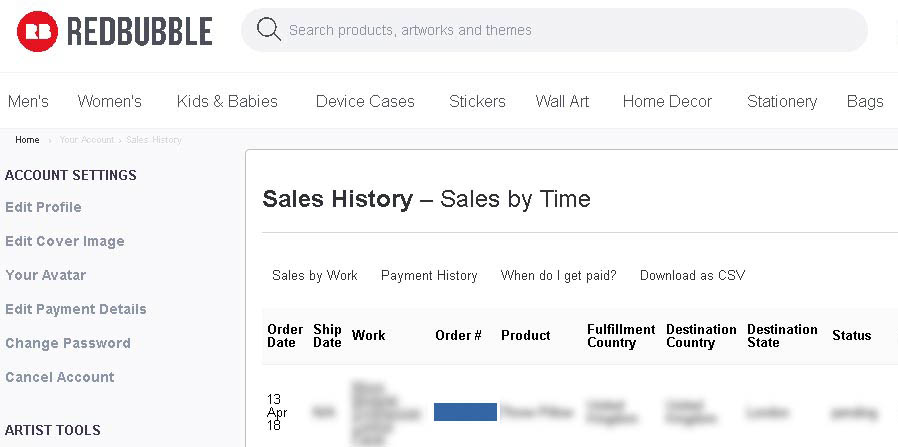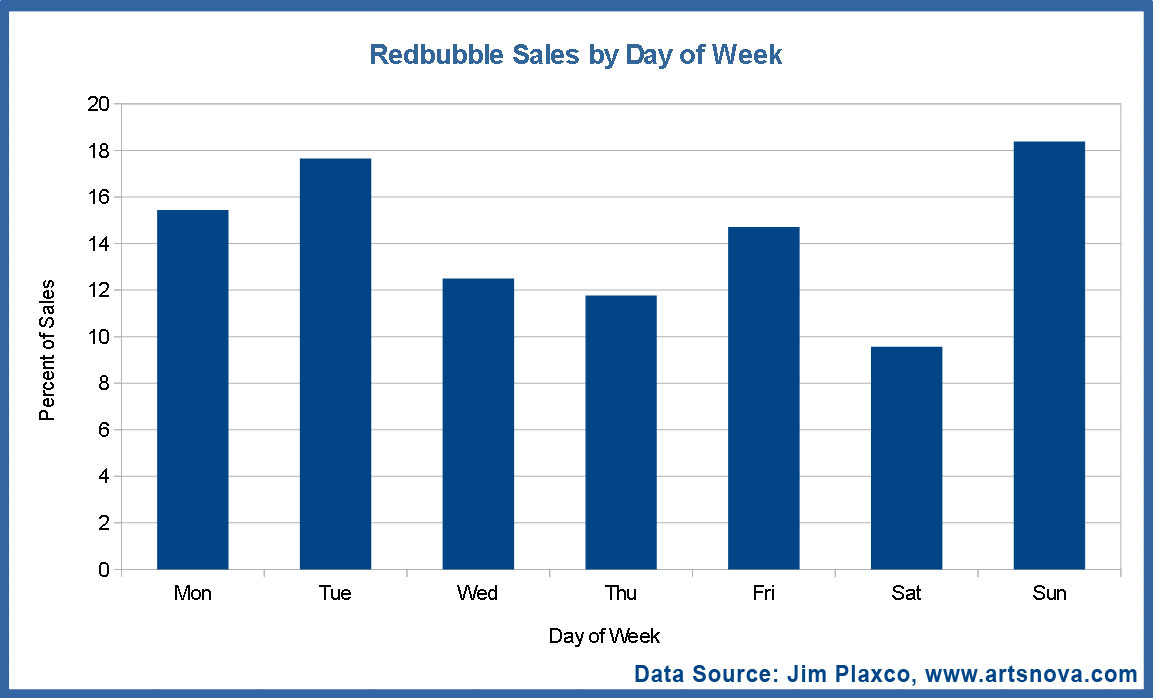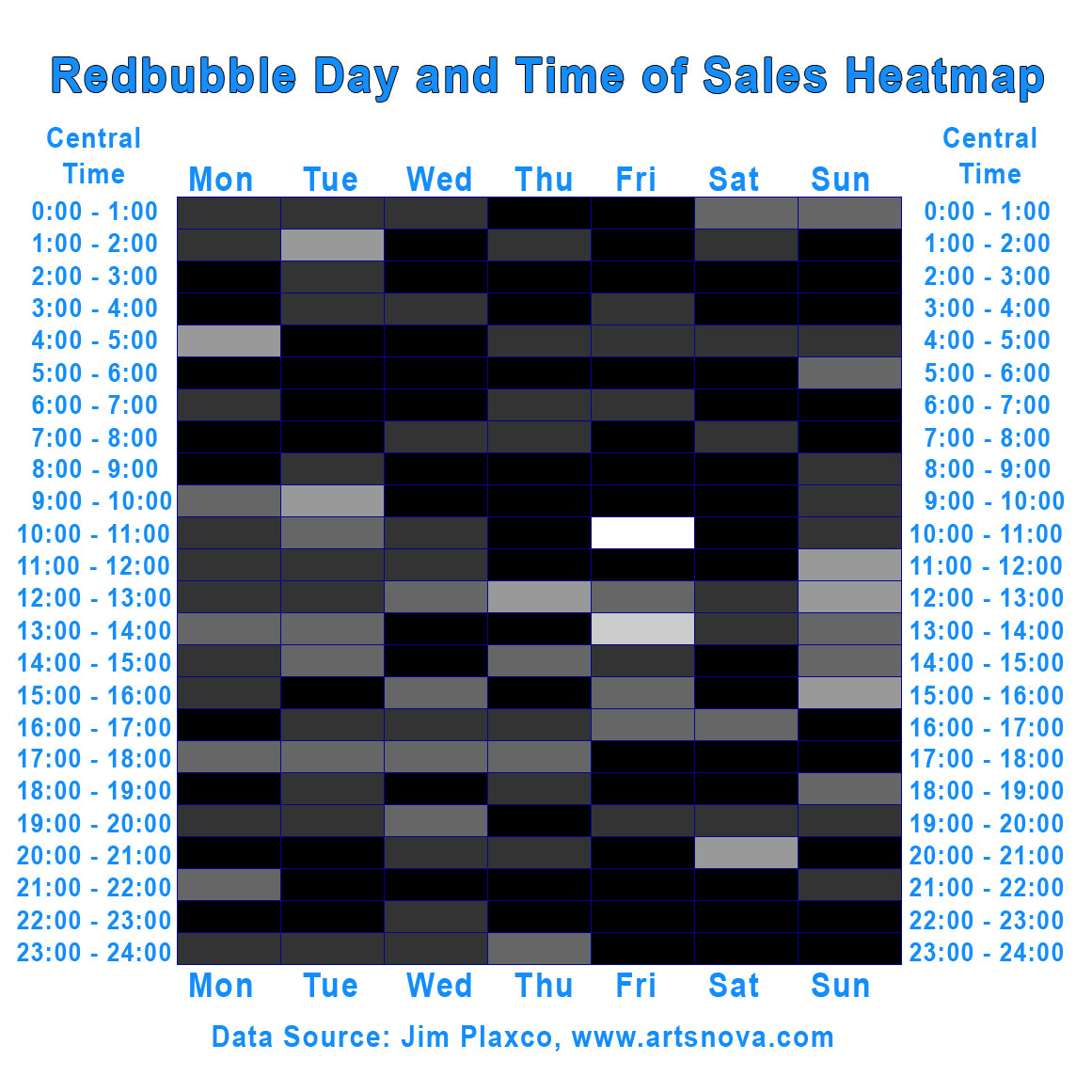Best Day and Time for Art Sales on Redbubble
Do a google search and you will find an abundance of results for answers to questions like "what is the best time to post on social media?" (For example, see my post Best Times to Post to Facebook, Linkedin, and Twitter) or "what is the best time to send email blasts?" or "what is the best time to sell on eBay?". But what about "what is the best time to sell on Redbubble?" Running this question past Google I got lots of results for "how to sell on Redbubble" but nothing regarding the "when" aspect.
Redbubble obviously knows the answer to the question of when most sales occur but doesn't share that information. In doing my income taxes this year, I was going over my merchandise sales on Redbubble and decided that I wanted to know when most of my sales on Redbubble were being made. So instead of continuing to work on my taxes as I should have, I decided to take a break and do some simple data analysis.
There were two questions I wanted to answer. First, what is the best day of the week for my Redbubble sales and second how are my sales distributed across the week by day of week and time of day.
The starting point for any analysis is getting the data needed to perform the analysis. When artists are logged in to their Redbubble account, on the Account Settings page (labeled as Account Details in the dropdown menu), there is an Artist Tools section with one of the menu items in that section being Sales History.

Redbubble Sales History CSV
Within Sales History there is a feature for downloading a CSV file of your sales history. The data in this file is very useful if you want to identify which of your artworks generate the most sales or the most income. It will also allow you to see which products are the most frequently sold. For this analysis, we are only interested in date and time of day when sales were made. While the file does have a field for the order date, there is no time of day information.
Fortunately I'm a pack rat when it comes to data. As a seller on Redbubble, generally when a sale is made I receive a "You've Made A Sale" email. I say generally because I've had multiple instances of receiving a "Manufacturing Invoice" email for which there was no companion "You've Made A Sale" email. What is useful about the "You've Made A Sale" email is that the email not only has the transaction date but it also has a time stamp. Assuming that Redbubble consistently generates these emails within 15 minutes of the actual transaction time, this data can be used as a proxy for the transaction time of day information.
Best Day of the Week for Redbubble Sales
The first analysis I did was to simply tally by day of week when sales were occurring and to then calculate what percentage of total sales happened on that day. The graph of that data is shown in Illustration 1: Redbubble Sales by Day of Week Graph at the top of this post while the following table ranks the days of the week in order of their sales volume.
| Day of Week |
Percent of Sales |
|---|---|
| Sunday | 18% |
| Tuesday | 18% |
| Monday | 15% |
| Friday | 15% |
| Thursday | 12% |
| Wednesday | 12% |
| Saturday | 09% |
The data for my sales indicates that the three day period of Sunday through Tuesday are when most of my sales are made and account for 51 percent of all sales. Note that if sales were evenly spread across all days, then any three days of sales would account for just under 43 percent of all sales. Saturday is clearly a trough day for me on Redbubble with only half the sales volume of the peak day.
Redbubble Sales Heatmap: Time of Day by Day of Week
Taking the analysis one step further, I broke out each day into the hour of the day in order to see at what time during the day sales were being made. Again I must point out that I do not know how closely the timestamp on the "You've Made A Sale" email correlates with the time the customer actually completed the transaction. For this analysis I assume a high degree of correlation.
Rather than using colors for this heatmap, I've opted to use a simple grayscale value since I'm simply looking at a single simple variable — sales frequency. The results are shown in Illustration 2: Redbubble Day of Week and Time of Day Sales Heatmap. A value of black means that no sales were made during that hour. A value of white represents the peak hour of the week. The rest of the grayscale values, from darkest to lightest, represent the range of least to most sales per hour.
The heatmap shows that the single best hour for sales during the week is during 10:00am to 11:00am on Friday, which is curious since Friday is not a peak day of the week. Sunday from 11:00am to 4:00pm appears to be the best block of time for sales during the week.
Is This Redbubble Sales Data Actionable?
So now I know when I'm making sales and my curiosity has been satisfied. But is there any way that I can use this data to my benefit? Maybe. For example, if there is a good correlation between the times that sales are made and the level of activity in the Redbubble Groups, posting artwork to the relevant groups during these peak sales hours may result in a sales boost.
Another possibility is dependent on the answer to the question "How much of a search results boost does Redbubble give to newly added artwork?" It's a given that the makers of search engines don't want to tip their hand as to how their search ranking algorithm works because they do not want people to "game the system" — which makes perfect sense. If we assume that a peak in sales corresponds with a peak in customer visits to Redbubble and if we also assume that Redbubble does give some sort of search results boost to new artwork, then an artist may marginally help their sales over time by adding new art to their account at the front end of a period of time for which the sales volume is above average.
Concluding Thought
There are a lot of unknowns associated with this analysis. A key unknown is just how well my sales data aligns with Redbubble's site-wide sales data. For those familiar with astronomy, there is the concept of the homogeneous universe. If that concept (that the universe is the same everywhere) applies to my sales data for Redbubble, then there will be a high degree of correlation between my results and the results that any other artist doing a similar analysis would get — in which case this analysis would be useful to anyone selling their art and/or photography on Redbubble.
For any artist or photographer engaged in selling on Redbubble, I hope you have found this information useful and that you will consider following me on Redbubble.
Visit Jim Plaxco's Artist Portfolio on Redbubble
| Return to the Blog Index | This entry was posted on Monday, April 16th, 2018 at 12:33 pm and is filed under Art Business, Print on Demand.

